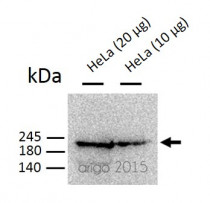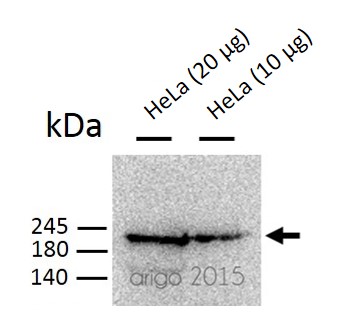ARG55201
anti-Dnmt1 antibody
anti-Dnmt1 antibody for ChIP,ICC/IF,Immunohistochemistry,Immunoprecipitation,Western blot and Human,Mouse,Rat
Gene Regulation antibody

1
Overview
| Product Description | Rabbit Polyclonal antibody recognizes Dnmt1 |
|---|---|
| Tested Reactivity | Hu, Ms, Rat |
| Tested Application | ChIP, ICC/IF, IHC, IP, WB |
| Host | Rabbit |
| Clonality | Polyclonal |
| Isotype | IgG |
| Target Name | Dnmt1 |
| Antigen Species | Human |
| Immunogen | Recombinant protein of Human Dnmt1 (Swiss: P26358) |
| Conjugation | Un-conjugated |
| Alternate Names | AIM; DNMT; MCMT; CXXC9; HSN1E; ADCADN; DNA (cytosine-5)-methyltransferase 1; Dnmt1; EC 2.1.1.37; CXXC-type zinc finger protein 9; DNA methyltransferase HsaI; DNA MTase HsaI; M.HsaI; MCMT |
Application Instructions
| Application Suggestion |
|
||||||||||||
|---|---|---|---|---|---|---|---|---|---|---|---|---|---|
| Application Note | * The dilutions indicate recommended starting dilutions and the optimal dilutions or concentrations should be determined by the scientist. | ||||||||||||
| Positive Control | HeLa |
Properties
| Form | Liquid |
|---|---|
| Purification | Affinity purification with immunogen. |
| Buffer | PBS (pH 7.3), 0.02% Sodium azide and 50% Glycerol |
| Preservative | 0.02% Sodium azide |
| Stabilizer | 50% Glycerol |
| Storage Instruction | For continuous use, store undiluted antibody at 2-8°C for up to a week. For long-term storage, aliquot and store at -20°C. Storage in frost free freezers is not recommended. Avoid repeated freeze/thaw cycles. Suggest spin the vial prior to opening. The antibody solution should be gently mixed before use. |
| Note | For laboratory research only, not for drug, diagnostic or other use. |
Bioinformation
| Database Links |
Swiss-port # P13864 Mouse DNA (cytosine-5)-methyltransferase 1 Swiss-port # P26358 Human DNA (cytosine-5)-methyltransferase 1 |
|---|---|
| Gene Symbol | DNMT1 |
| Gene Full Name | DNA (cytosine-5-)-methyltransferase 1 |
| Background | DNA (cytosine-5-)-methyltransferase 1 has a role in the establishment and regulation of tissue-specific patterns of methylated cytosine residues. Aberrant methylation patterns are associated with certain human tumors and developmental abnormalities. Two transcript variants encoding different isoforms have been found for this gene. [provided by RefSeq, Aug 2008] |
| Function | Methylates CpG residues. Preferentially methylates hemimethylated DNA. Associates with DNA replication sites in S phase maintaining the methylation pattern in the newly synthesized strand, that is essential for epigenetic inheritance. Associates with chromatin during G2 and M phases to maintain DNA methylation independently of replication. It is responsible for maintaining methylation patterns established in development. DNA methylation is coordinated with methylation of histones. Mediates transcriptional repression by direct binding to HDAC2. In association with DNMT3B and via the recruitment of CTCFL/BORIS, involved in activation of BAG1 gene expression by modulating dimethylation of promoter histone H3 at H3K4 and H3K9. [UniProt] |
| Research Area | Gene Regulation antibody |
| Calculated MW | 183 kDa |
| PTM | Sumoylated; sumoylation increases activity. Acetylation on multiple lysines, mainly by KAT2B/PCAF, regulates cell cycle G(2)/M transition. Deacetylation of Lys-1349 and Lys-1415 by SIRT1 increases methyltransferase activity. Phosphorylation of Ser-154 by CDKs is important for enzymatic activity and protein stability. Phosphorylation of Ser-143 by AKT1 prevents methylation by SETD7 therebye increasing DNMT1 stability. Methylation at Lys-142 by SETD7 promotes DNMT1 proteasomal degradation. Ubiquitinated by UHRF1; interaction with USP7 counteracts ubiquitination by UHRF1 by promoting deubiquitination and preventing degradation by the proteasome. |
Images (2) Click the Picture to Zoom In









